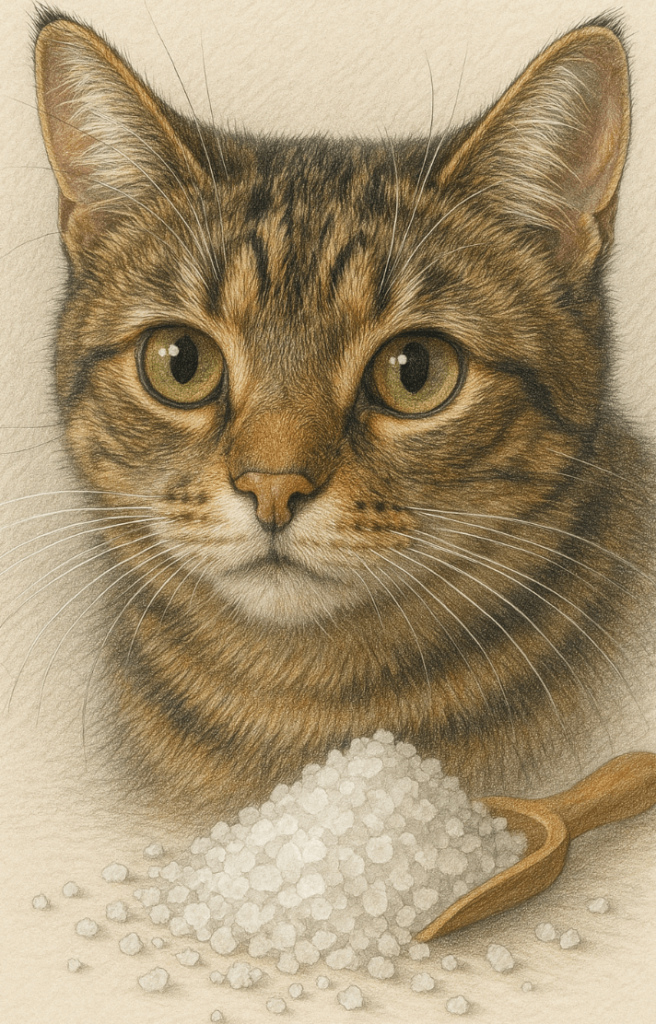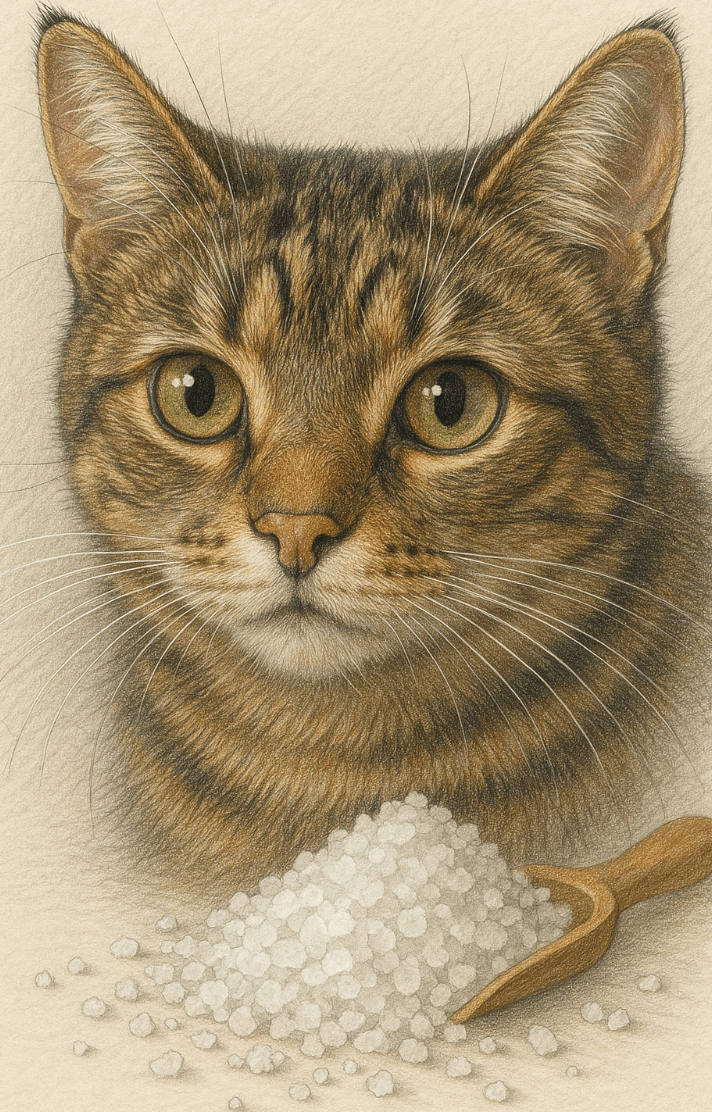Can Cats Eat Sea Salt?
As a cat owner, you may have wondered whether certain human foods or seasonings are safe for your feline friend. One such question that often arises is whether cats can eat sea salt. While sea salt is a common ingredient in our diets, it’s important to understand how it affects cats, whose nutritional needs and tolerances differ significantly from ours. In this blog post, we’ll explore the potential risks and benefits of sea salt for cats, discuss safer alternatives, and provide practical tips for keeping your furry companion healthy. Let’s dive into everything you need to know about cats and sea salt.
Potential Risks of Sea Salt for Cats
While sea salt is not inherently toxic to cats, it can pose serious health risks if consumed in large quantities. Understanding these dangers is crucial to ensuring your cat’s well-being.
Sodium Ion Poisoning:
Excessive sodium intake can lead to sodium ion poisoning, causing symptoms like vomiting, diarrhea, and seizures.Dehydration:
High salt levels can dehydrate your cat, as their bodies struggle to process and eliminate excess sodium.Kidney Damage:
Over time, excessive salt consumption may strain your cat’s kidneys, potentially leading to long-term damage.Behavioral Changes:
Cats exposed to too much salt may exhibit lethargy, confusion, or loss of appetite due to the body’s stress response.Increased Blood Pressure:
A high-sodium diet can elevate blood pressure, increasing the risk of heart-related issues in cats.
These risks highlight the importance of monitoring your cat’s exposure to sea salt and other salty substances.
Signs Your Cat May Have Consumed Too Much Salt
If your cat accidentally ingests sea salt or salty foods, it’s essential to recognize the warning signs early. Here’s what to look out for.
Excessive Thirst:
Cats drinking more water than usual may be trying to compensate for dehydration caused by salt intake.Frequent Urination:
Increased urination is another sign of the body attempting to flush out excess sodium.Lethargy or Weakness:
A sudden lack of energy or difficulty moving could indicate sodium toxicity.Tremors or Seizures:
Neurological symptoms like tremors or seizures are serious red flags requiring immediate veterinary attention.Vomiting or Diarrhea:
Gastrointestinal distress is a common reaction to salt poisoning in cats.
Recognizing these symptoms early allows you to seek veterinary care promptly, preventing further complications.
Check this guide 👉Can Cats Eat Pork? Best 7 Expert Tips!
Check this guide 👉Can Cats Eat Saffron? Best 7 Expert Tips!
Check this guide 👉Can Cats Eat Cinnamon? Best 7 Expert Tips!

Safe Foods for Cats | Foods to Avoid Feeding Cats |
|---|---|
Plain cooked chicken (no salt) | Salty snacks like chips or pretzels |
Fresh fruits (e.g., blueberries) | Processed meats like bacon or ham |
Steamed vegetables (e.g., peas) | Sea salt or table salt |
Bone broth (low-sodium) | Canned soups or sauces with salt |
Cat-safe treats (unsalted) | Fast food or junk food |
How to Prevent Salt Exposure in Cats
Prevention is key when it comes to protecting your cat from the dangers of sea salt. Follow these tips to minimize their risk of salt-related issues.
Store Salty Foods Safely:
Keep salty snacks, seasonings, and processed foods out of your cat’s reach to prevent accidental ingestion.Avoid Sharing Human Food:
Many human foods contain hidden salts; avoid feeding your cat anything not specifically formulated for them.Monitor Treat Ingredients:
Check labels on cat treats to ensure they are free from added salts or artificial flavorings.Provide Fresh Water Always:
Ensure your cat has constant access to clean, fresh water to help flush out any minor salt intake.Supervise Curious Cats:
If your cat shows interest in salty foods, redirect their attention to safer alternatives like cat-safe toys or treats.
By taking these precautions, you can create a safer environment for your cat and reduce the risk of salt-related health problems.
What to Do If Your Cat Eats Sea Salt
Accidents happen, and if your cat consumes sea salt or salty foods, acting quickly is essential. Here’s what you should do in such situations.
Assess the Situation:
Determine how much salt your cat has ingested and observe for any immediate symptoms like excessive thirst or lethargy.Contact Your Veterinarian:
Call your vet immediately for advice, even if your cat seems fine, as symptoms may take time to appear.Do Not Induce Vomiting Without Guidance:
Forcing your cat to vomit can sometimes worsen the situation; always consult a professional first.Offer Fresh Water:
Encourage your cat to drink water to help dilute the salt in their system, but don’t force them.Monitor Closely:
Keep a close eye on your cat for at least 24 hours to watch for delayed symptoms of salt toxicity.
Prompt action can make all the difference in ensuring your cat recovers safely from accidental salt ingestion.
Common Misconceptions About Cats and Salt
There are several misconceptions about cats and salt that can lead to unintentional harm. Clarifying these myths helps pet owners make better decisions.
Cats Need Salt Like Humans Do:
Unlike humans, cats require very little sodium, which they already get from their balanced cat food.A Little Salt Won’t Hurt Them:
Even small amounts of salt can disrupt a cat’s delicate balance, especially if consumed regularly.Salt Is Safe in Treats:
Many commercial treats contain added salt; always check labels to ensure they are cat-safe.Cats Can Handle Salty Fish Naturally:
While cats are drawn to fish, the high salt content in many varieties can still harm them.Salt Is Only Dangerous in Large Quantities:
Even moderate amounts can lead to dehydration or other health issues over time.
Dispelling these myths ensures a deeper understanding of your cat’s dietary needs.
Healthier Alternatives to Satisfy Your Cat’s Cravings
If your cat seems curious about salty flavors, consider offering healthier alternatives that satisfy their cravings without the risks.
Plain Cooked Meat:
Offer small pieces of plain, unsalted chicken or turkey as a safe and tasty treat.Cat Grass:
Some cats enjoy nibbling on cat grass, which provides fiber and satisfies chewing instincts.Low-Sodium Broth:
Serve a small amount of low-sodium, unseasoned broth as an occasional treat.Freeze-Dried Treats:
Choose freeze-dried liver or meat treats made specifically for cats, ensuring they’re free of added salts.Fresh Water Infusions:
Add a splash of low-sodium chicken broth to your cat’s water bowl for variety without the risks of salt.
These alternatives allow you to cater to your cat’s curiosity while keeping them safe and healthy.
Tips for Transitioning to a Low-Salt Diet for Cats
If your cat has been exposed to salty foods, transitioning them to a healthier, low-salt diet can improve their overall well-being.
Gradual Changes:
Slowly introduce new, low-salt foods to avoid upsetting your cat’s digestive system.Read Labels Carefully:
Always check ingredient lists on cat food and treats to ensure they are free from added salts or fillers.Focus on Hydration:
Encourage your cat to drink more water by using a pet fountain or flavoring their water with a drop of low-sodium broth.Consult Your Vet:
Work with your veterinarian to develop a balanced diet plan tailored to your cat’s specific needs.Be Patient:
Cats may take time to adjust to new foods; persistence and consistency are key to success.
By following these tips, you can help your cat transition to a healthier diet while minimizing risks.
Frequently Asked Questions About Cats and Sea Salt
Is sea salt safe for cats in small amounts?
No, even small amounts of sea salt can be harmful to cats, as their bodies are not designed to process sodium efficiently.
Can cats eat salty fish like tuna?
While cats may enjoy the taste, salty fish should be avoided or rinsed thoroughly to remove excess sodium before feeding.
What should I do if my cat licks a salty surface?
Monitor your cat closely for symptoms of salt ingestion and contact your vet if you notice any unusual behavior.
Are there any benefits to giving cats salt?
Cats derive all the sodium they need from their regular diet; additional salt offers no health benefits and can be harmful.
How much salt is too much for a cat?
Even a teaspoon of salt can be dangerous for a cat, depending on their size and overall health.
Prioritizing Your Cat’s Health Around Salt
While sea salt may be a staple in our kitchens, it has no place in your cat’s diet. Understanding the risks associated with salt consumption and taking steps to prevent exposure can help keep your feline friend healthy and happy. By focusing on safe, cat-friendly foods and remaining vigilant about their environment, you can ensure your cat enjoys a long and fulfilling life. Remember, your cat relies on you to make the best dietary choices for them—so always prioritize their well-being above all else.
Can a Cat Die from a Cold? Best 7 Expert Tips! Learn how to identify, treat, and prevent feline colds while understanding when to seek veterinary care for your cat’s health.
Cat Screaming for Food: Best 7 Expert Tips! Discover effective strategies to manage your cat's food-related vocalizations and create a peaceful feeding routine.
Aspiration Pneumonia in Cats: Best 7 Expert Tips! Discover causes, symptoms, and treatment advice to protect your cat’s respiratory health and ensure a speedy recovery.
Hip Dysplasia in Cats: Best 7 Expert Tips! Discover expert advice on managing hip dysplasia in cats, from symptoms and prevention to treatment options for a happier, healthier feline life.





